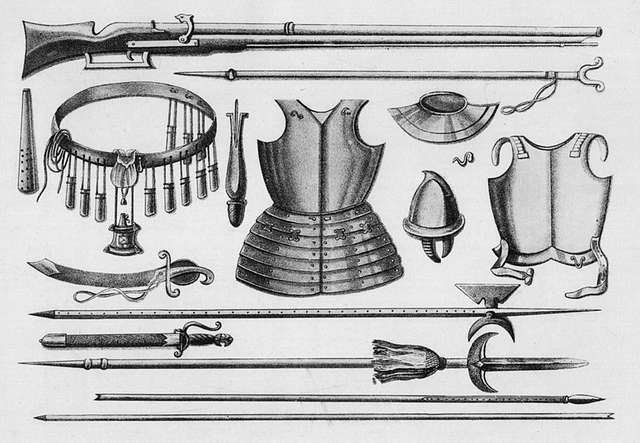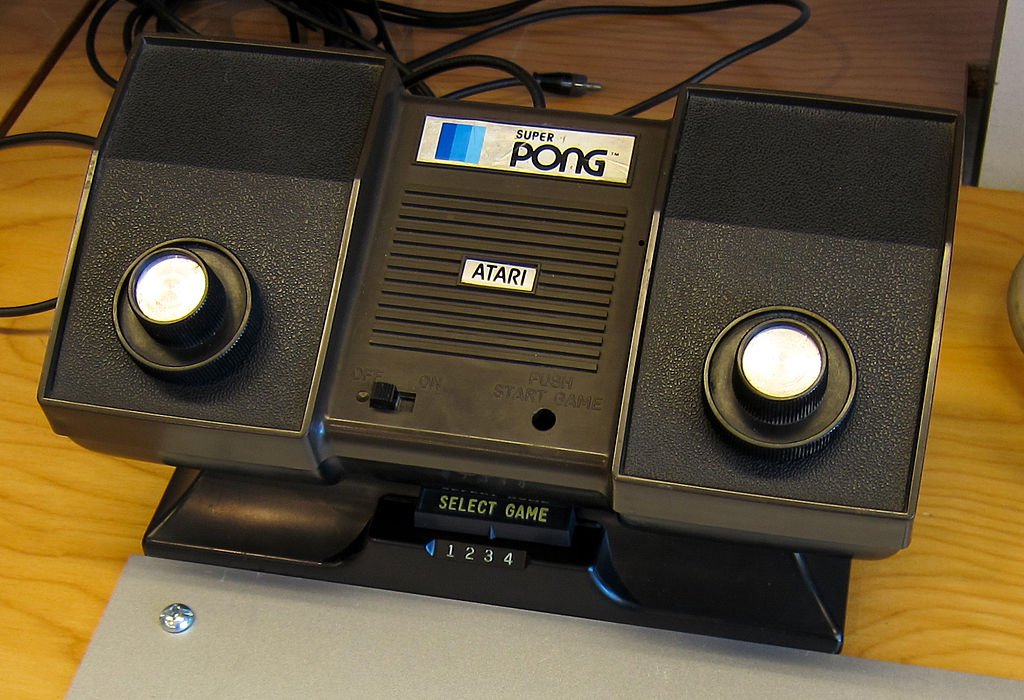In the world of video game history, few titles hold as much significance as “Pong,” the pioneering creation of Atari that marked the advent of the arcade gaming era. Conceived in the early 1970s by Nolan Bushnell and brought to life by Atari engineer Allan Alcorn, Pong emerged as a simple yet revolutionary electronic recreation of table tennis. The journey from its conceptualization to commercial release not only shaped the trajectory of Atari but also laid the foundation for the entire video game industry.
Atari, founded by Bushnell and Ted Dabney in 1972, sought to democratize video games, making them accessible to a broader audience beyond academic and research institutions. With a vision in mind, Bushnell tasked Alcorn with developing a game that would captivate players with its simplicity and entertainment value. The result was Pong, a virtual ping-pong experience that featured two paddles and a bouncing ball.
The prototype of Pong found its home in a local bar, “Andy Capp’s Tavern” in Sunnyvale, California. The overwhelmingly positive response from patrons signaled the game’s potential success. Encouraged by this reception, Atari moved swiftly to release Pong commercially, installing the first arcade machine in the same tavern in November 1972.
Pong’s gameplay was elegantly straightforward—two players, each controlling a paddle, attempted to volley a digital ball back and forth. The controls were basic, typically involving a knob or joystick for moving the paddles. This simplicity, coupled with the competitive nature of the game, resonated with players and contributed to its widespread popularity.
Pong’s triumph transcended the confines of a local bar, leading Atari to mass-produce and distribute the game, making it a ubiquitous presence in arcades and entertainment venues. Its success marked a pivotal moment in the nascent video game industry, transforming Atari into a significant player and inspiring the development of countless games that followed.
Table of Contents
When did Atari introduce Pong?
Atari introduced Pong in November 1972. Conceived by Nolan Bushnell and developed by Atari engineer Allan Alcorn, Pong marked a pivotal moment in the history of video games. The game’s prototype was installed in a local bar, “Andy Capp’s Tavern” in Sunnyvale, California, where it garnered an overwhelmingly positive response from patrons. Encouraged by its success, Atari swiftly moved to release Pong commercially. The first arcade machine was officially installed in the same tavern in November 1972. Pong’s simple yet engaging gameplay, featuring two paddles and a bouncing ball, revolutionized the gaming landscape and played a crucial role in establishing Atari as a key player in the burgeoning video game industry.
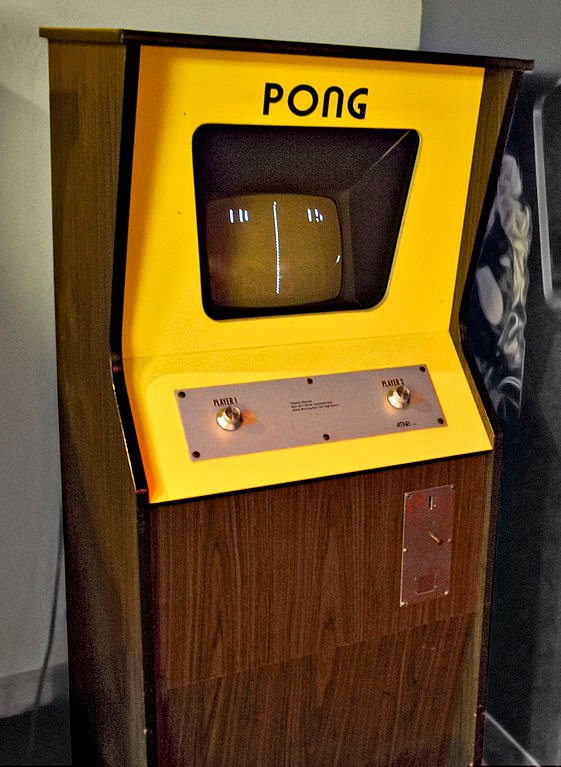
Who invented the Ping-Pong game?
Ping-Pong, also known as table tennis, was not invented by a single individual but evolved over time. The game originated in England during the late 19th century as an indoor alternative to lawn tennis. Initially called “whiff-whaff,” it involved using household objects like books as paddles and a rounded cork or rubber ball.
The modern version of table tennis, resembling the game we know today, developed in the early 20th century. In 1926, the International Table Tennis Federation (ITTF) was founded, establishing standardized rules for the sport. The name “Ping-Pong” was trademarked by the Parker Brothers in the early 20th century, leading to its association with the game. While it was a trademarked name, the term is often used interchangeably with table tennis. Therefore, the credit for the invention of Ping-Pong as a standardized and organized sport goes to the collaborative efforts of early enthusiasts and the establishment of the ITTF.
Why was Pong so famous?
Pong achieved fame for several reasons. First, it was one of the earliest commercially successful video games, capturing public attention during the nascent stage of the gaming industry. Its simplicity and intuitive gameplay made it accessible to a broad audience, attracting both avid gamers and those new to electronic entertainment.
Moreover, Pong’s strategic placement in bars and arcades exposed it to a diverse demographic, contributing to its widespread popularity. The competitive and interactive nature of the game fostered social engagement, turning Pong into a communal experience. Its success established Atari as a key player in the gaming market, setting the stage for the industry’s exponential growth. Pong’s cultural impact endures as it is often regarded as a symbol of the birth of video gaming, leaving an indelible mark on the collective memory of gaming enthusiasts worldwide.
Did Atari make Pong?
Yes, Pong was indeed made by Atari. In 1972, Atari, founded by Nolan Bushnell and Ted Dabney, tasked engineer Allan Alcorn with creating a simple yet engaging video game. Alcorn developed Pong, a virtual table tennis simulation featuring two paddles and a bouncing ball. The game’s prototype was initially installed in a local bar, “Andy Capp’s Tavern,” where it received an overwhelmingly positive response. Recognizing its potential, Atari decided to release Pong commercially, and the first arcade machine was installed in the same tavern in November 1972. Pong’s success not only established Atari as a key player in the emerging video game industry but also played a pivotal role in shaping the trajectory of electronic gaming.
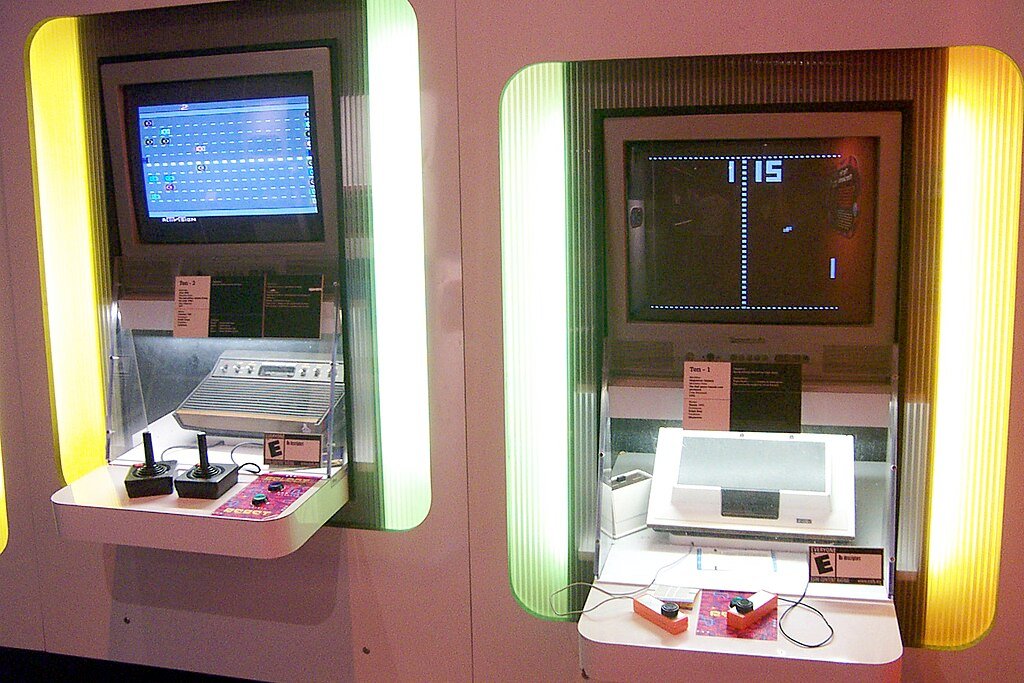
Pong’s Debut: Atari’s Game-Changing Introduction
Atari introduced Pong, one of the earliest arcade video games, in 1972. Pong is often considered the first commercially successful video game and played a significant role in the development of the video game industry.
Here’s a detailed overview of the introduction of Pong:
Background
In the early 1970s, the landscape of video games differed significantly from today’s ubiquitous presence. During this era, electronic games were confined to specialized research labs and academic institutions, far from the mainstream entertainment they represent today. The gaming revolution, however, was on the horizon. Atari co-founder Nolan Bushnell played a pivotal role in steering it towards a broader audience.
Inspiration struck Bushnell as he witnessed the success of “Spacewar!” developed at MIT in the early 1960s. This groundbreaking game, albeit limited to academic circles, showcased the potential for interactive electronic entertainment. Bushnell, fueled by a vision to bring gaming to the masses, co-founded Atari in 1972. The creation of Pong, Atari’s first commercially successful arcade game, marked the realization of this vision. By simplifying the gaming experience and placing it in public spaces, Bushnell and Atari played a key role in transforming video games from niche experiments to a global cultural phenomenon. This shift laid the groundwork for the expansive and diverse video game industry we know today.
Creation of Atari
In 1972, Nolan Bushnell and Ted Dabney embarked on a groundbreaking venture by co-founding Atari Incorporated, driven by a visionary goal: to bring the enchantment of video games to the masses. Their collaboration marked the genesis of an iconic era in the gaming industry. Bushnell, a visionary entrepreneur, conceptualized a novel idea that would redefine entertainment — the creation of a simple, tennis-like game accessible to everyone via a television screen.
This brainchild materialized as Pong, a pioneering arcade game that simulated the thrill of table tennis. Bushnell’s vision extended beyond the confines of niche research labs, aiming to make electronic gaming a universal experience. The founding of Atari represented a bold step toward democratizing video games, transforming them from obscure novelties into a cultural phenomenon. Little did they know that their ambitious pursuit would lay the groundwork for an entire industry, sparking a revolution that continues to shape the way we play and engage with interactive entertainment today. The establishment of Atari in 1972 marked the inception of a transformative journey that would forever alter the landscape of gaming, making it accessible, enjoyable, and integral to popular culture.
Development of Pong
Atari engineer Allan Alcorn was assigned the crucial task of developing the game that would become Pong. Tasked with creating a compelling electronic experience, Alcorn crafted the initial version as a simplified tennis simulation. This rudimentary rendition comprised two paddles and a bouncing ball, reflecting the essence of table tennis in a digital format.
Alcorn’s genius lay not only in the conceptualization but also in simplifying the gameplay for widespread appeal. Recognizing the need for accessibility, he designed the game with straightforward controls, allowing players to move their paddles up and down. The intuitive and basic mechanics of Pong contributed significantly to its success, as players, whether seasoned gamers or novices, could grasp the gameplay swiftly. Alcorn’s deliberate efforts to make Pong simple and easy to understand proved instrumental in its widespread popularity and played a crucial role in laying the foundation for the burgeoning video game industry of the 1970s.
Prototype Testing
The inaugural prototype of Pong found its first home in the welcoming confines of Andy Capp’s Tavern, a local bar nestled in Sunnyvale, California. This unassuming location would unknowingly become the birthplace of a cultural phenomenon. As the patrons at Andy Capp’s laid eyes on the mesmerizing electronic spectacle for the first time, their reaction was nothing short of enthusiastic jubilation. The simplicity of Pong’s virtual table tennis, coupled with its engaging gameplay, resonated with the patrons, drawing them into the immersive world of arcade gaming.
Word of the groundbreaking game spread like wildfire, and soon, Andy Capp’s Tavern became a bustling hub of excitement. The Pong machine’s overwhelming popularity transformed quiet evenings into lively and crowded affairs, as patrons eagerly vied for their turn to experience the digital thrill of Pong. Little did they know that their positive reactions were the heralds of a revolution in entertainment, marking the inception of an era where electronic gaming would capture the hearts and minds of people worldwide.
Commercial Release
Following the resounding success of Pong’s prototype, Atari swiftly made the strategic decision to officially release the game as an arcade sensation. This pivotal move marked the transition of Pong from a local experiment to a commercially viable entertainment experience. In November 1972, the inaugural commercial Pong arcade machine found its home in a bar known as “Andy Capp’s.” This establishment in Sunnyvale, California, became the launching pad for what would become a cultural phenomenon. The decision to debut Pong in a social setting such as a bar was instrumental in gauging its popularity among patrons, who were quick to embrace the novel electronic game.
The installation of the first commercial Pong machine at “Andy Capp’s” not only symbolized the game’s official entry into the market but also acted as a catalyst for the widespread adoption of arcade gaming. This strategic placement in a social hub set the stage for Pong’s meteoric rise, as word-of-mouth and the contagious thrill of the game spread rapidly, laying the foundation for Atari’s ascent and the subsequent revolution of the video game industry.
Gameplay
Pong, a groundbreaking creation by Atari in 1972, simulated a virtual table tennis or ping-pong experience that captivated players worldwide. The gameplay involved two players, each controlling a paddle situated on opposite sides of the screen. In the spirit of the classic table tennis game, the objective was simple yet engrossing: to skillfully maneuver the paddles and volley a digital ball back and forth.
Players, armed with a knob or joystick as their control interface, skillfully navigated their respective paddles, aiming to outmaneuver their opponent and score points. The intuitive controls allow for precise movements, adding a layer of strategy and skill to the seemingly straightforward game. Success in Pong relied on a combination of reflexes, timing, and strategic anticipation, as players sought to outplay their counterparts in this virtual recreation of the classic sport.
The scoring system was straightforward — points were earned when one player successfully caused the opponent to miss hitting the ball. Pong’s elegant simplicity, coupled with its competitive nature, contributed significantly to its widespread popularity, setting the stage for the evolution of the video game industry and solidifying its place in the annals of gaming history.
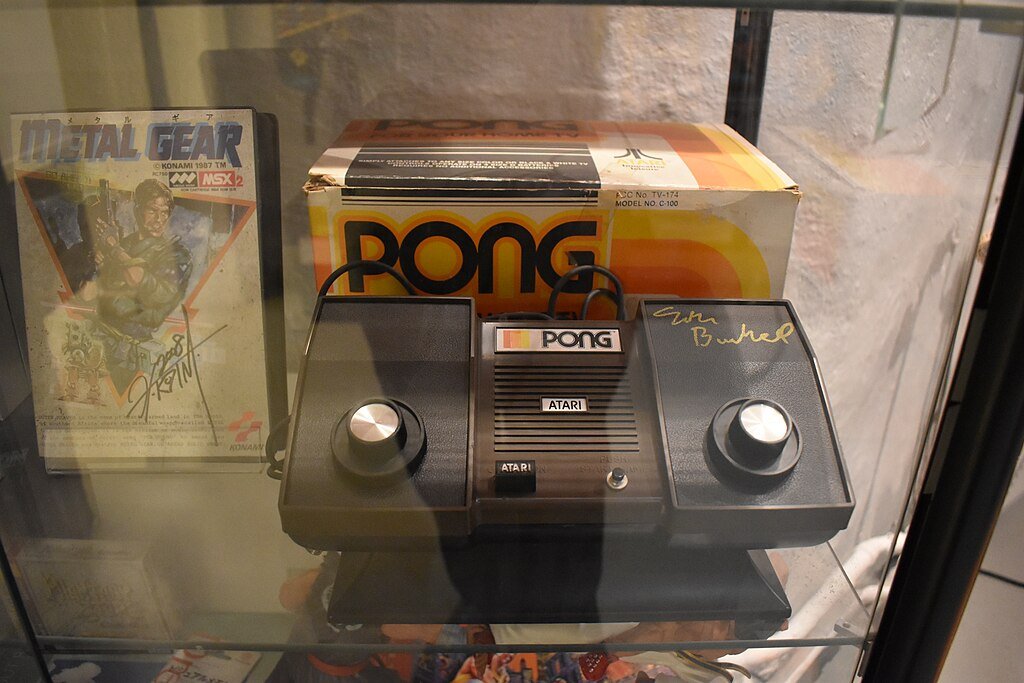
Success and Impact
Pong’s immediate success propelled it into the forefront of arcade gaming, sparking a revolution in the entertainment landscape. Atari swiftly recognized the game’s immense appeal and commenced mass production and distribution of Pong arcade machines. This strategic move by Atari not only solidified the company’s position in the burgeoning video game industry but also laid the foundation for the widespread popularity of arcade gaming during the 1970s.
As Pong arcade machines flooded the market, they found a welcoming home in arcades, bars, and various entertainment venues. The game’s simple yet addictive gameplay, involving two players controlling paddles to volley a digital ball, resonated with people from all walks of life. Its intuitive controls and competitive nature made it a social phenomenon, attracting crowds and establishing Pong as a cultural staple.
Atari’s manufacturing and marketing efforts ensured that Pong became more than just a game; it became a shared experience, fostering a new era of communal entertainment. The widespread adoption of Pong laid the groundwork for the subsequent arcade gaming boom, influencing the direction of the video game industry and leaving an indelible mark on the collective memory of gaming enthusiasts.
Legacy
Pong’s unprecedented success in the early 1970s played a pivotal role in heralding the advent of the video game industry. Atari’s introduction of Pong marked a transformative moment, captivating audiences and laying the groundwork for an entire entertainment sector. The game’s widespread popularity not only demonstrated the public’s appetite for interactive electronic entertainment but also established Atari as a central figure in this burgeoning industry.
Pong’s triumph can be attributed to its simplicity and accessibility. The game’s intuitive design, featuring two paddles and a bouncing ball, made it easy for players of all ages to grasp and enjoy. The straightforward controls, typically involving a knob or joystick, contributed to its broad appeal. This accessibility became a hallmark of Pong and set a precedent for future video games.
The success of Pong had a lasting impact, influencing the direction of game development and inspiring a new wave of interactive entertainment. Its popularity laid the foundation for the growth of the video game industry, with Atari emerging as a key player that would continue to shape the evolving landscape of electronic gaming for years to come. Pong’s legacy is not merely confined to its own achievements but extends to the instrumental role it played in paving the way for the subsequent development and success of a diverse array of video games.
Pong stands as a groundbreaking game that played a pivotal role in shaping the trajectory of the video game industry during its formative years. Introduced by Atari in 1972, Pong revolutionized the gaming landscape, marking the advent of arcade gaming as a cultural phenomenon. Its simple yet captivating virtual table tennis simulation, where players controlled paddles to volley a digital ball, resonated with audiences, transcending the realm of niche electronic entertainment.
Pong’s unparalleled success not only established Atari as a significant player in the burgeoning video game market but also contributed significantly to the industry’s evolution. The game’s widespread popularity paved the way for the subsequent proliferation of arcade machines, establishing a new form of interactive entertainment. Beyond its immediate impact, Pong’s legacy endures as a symbol of innovation, laying the foundation for the expansive and diverse world of video gaming that we recognize today. In essence, Pong’s introduction was not merely the birth of a game but a catalyst for the cultural phenomenon that is video gaming.
